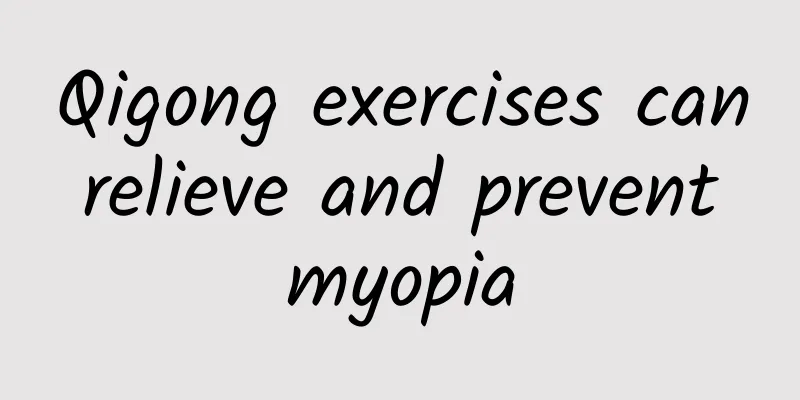Qigong exercises can relieve and prevent myopia

|
After a large amount of clinical practice, the effectiveness of qigong in treating myopia is confirmed. The exercise is divided into ten sections, with the following features: 1. highlighting the characteristics of Qigong; 2. targeting the causes of myopia; 3. being simple and easy to learn and taking only ten minutes. The steps are as follows: The first session is to relax your whole body: Stand with your feet parallel and shoulder-width apart. Bend your knees slightly, half-open and half-close your eyes, and press your tongue against the upper jaw. Place your palms together and gradually relax from the Baihui point on the top of your head to your face, neck, chest, back, abdomen, thighs, calves, and feet. Function: Regulate Qi and blood, dredge meridians, mobilize the body's inherent potential, exert self-regulating physiological functions, and inhibit adverse reflexes of eye diseases. Modern medicine points out that the blood circulation speed of the whole body is inversely proportional to the tension of the muscles. Focusing on relaxing the legs and improving blood circulation is beneficial to improving eyesight. The second section: Qi flows through the "Dantian" Place your palms facing each other from the Baihui point on the top of the head and gradually move as you inhale through the face, neck, chest and back, abdomen and waist, and then to the Dantian. Stop for a moment. Make your hands like holding a ball, and imagine that the air is released from the Dantian to the Tanzhong point along the three yin meridians of both hands to the Laogong point. Then open and close your hands (exhale, imagine the air reaching the Laogong point, and put your palms together). Function: Use "internal energy" to gather in the "dantian" to strengthen the circulation of qi and blood in the body to prepare for external qi to support the eyes. The third section: External Qi supports the eyes: Guide the energy in the "Dantian" to both hands and the "Laogong point" at will, and slowly bring it closer to the eyes. Open your eyes wide so that the external energy can enter the eyeballs. Function: It delivers "external air" to the eyes, making the eyeballs feel sore, heavy, burning or cool. It can moisten the eyes, make the eyes comfortable and enable clear vision. This method of transmitting the body's own information back to the eyes through the "Laogong" so that the diseased eye fire can gain new coordination is also called the biological feedback method. Section 4: Moving the Eyes with the Mind: Close your eyes, keep your eyeballs still, and use your mind to rotate your eyes, first clockwise and then counterclockwise. Then slowly raise your head and open your eyes to look at the sky. Function: It has been proposed recently that the ciliary muscle is controlled by the neocortex and limbic cortex of the brain, and that one can also rely on one's own will to control the ciliary muscle to restore vision. The fifth section: Observing the Heaven and the Movement: Look up at the sky, move your eyeballs, and let your gaze move around the sky, first clockwise and then counterclockwise. Function: Looking into the distance is a resting state for the eyes, that is, a relaxed state, which exercises the eyeballs and increases blood circulation in the eye area. Chapter 6: In a blink of an eye: Don't move your head. Move your eyeballs upward and downward as far as possible (look up at your eyebrows, look down at the nearest tip of your nose), and then move your eyeballs left and right as far as possible (try to look at your left and right ears). Function: Allow the eyeball to move to the maximum extent and adjust the function of the ciliary muscle. Section 7: Close your eyes and adjust your eyes: Close your eyes and concentrate, inhale while moving your eyeballs to the left, exhale while moving your eyeballs to the right, then focus for a moment, suddenly open your eyes and look at a point in front. Function: It relaxes the ciliary muscle and massages the eyeball. Section 8: Far and Near Adjustment: When you inhale, look at the farthest point in front of you (make sure you see clearly); when you exhale, look at the closest point, and alternate between these steps. Function: This conversion of near and far vision allows the ciliary muscle to rest actively, improves blood circulation, and exercises the ciliary muscle's regulatory function. When exhaling, looking at something close at the same time can further shrink the pupil due to the near point reaction; when inhaling, the sympathetic nerves are excited, which can dilate the pupil. At the same time, looking far away can further dilate the pupil. The regular and large-scale contraction and relaxation of the pupil brings about the activity of the ciliary muscle, which results in the following: 1. The contraction and relaxation of the circular fibers of the ciliary muscle drive the ligaments of the lens, which in turn drives the lens to increase its ability to adjust refractive power. 2. The ciliary muscle contracts and relaxes through fibers, driving the opening and closing of the scleral sinuses, promoting the circulation of aqueous humor, allowing metabolic products in the eyeball to be discharged in a timely manner and nutrients to be supplied in a timely manner. Section 9: Qigong Acupoint Pressing: Use your mind to guide the Qi in the "Dantian" to the thumbs of both hands. Cross your thumbs and press the eye sockets and the painful points on the upper inner edge. Function: The sensory nerves at the inner edge of the orbit are most abundantly distributed. When there is a disease, the stagnation of qi and blood in the meridians here will cause tenderness. After qigong acupressure, the sensitive points disappear and the eye disease is cured. Section 10: Empty Neck and Top Neck: Relax your neck and stretch it as much as possible. Lift both heels at the same time (toes should not leave the ground), stretch your neck upward, land your feet on the ground, and relax your neck. Effect: It is proposed that myopia is related to small misalignment of the cervical spine (some people report 85%) in order to correct posture. This exercise mainly widens the cervical intervertebral space. "Empty neck" means relaxing the top of the neck. "Stretching neck" means lengthening the top of the neck (meaning pulling), thus improving myopia. Qigong exercises precautions: 1. I hope those who learn the exercises will be sincere and understand them carefully. 2. Wash your hands and face before practicing each time, and keep the exercise materials clean. 3. Practice the exercises for ten minutes in the morning and evening. Do not think about other things while practicing. |
>>: Yellow hands, yellow eyes, and yellow urine indicate liver and gallbladder problems
Recommend
How to reduce belly fat after childbirth
Being a mother is a very happy thing. Having a ba...
Is the air in Sanya good for human health? What fish are there in the rivers of Sanya?
Sanya has a beautiful environment. It not only ha...
Can women do sit-ups one month after cesarean section?
Many expectant mothers give birth by caesarean se...
Why is Zibo barbecue famous? Where is the hometown of Zibo kiwifruit?
Recently, many friends have gone to Zibo, not onl...
What kind of sanitary napkin is good to use during menstruation
Menstruation is a very important period for women...
Is the natural cream suitable for all skin types? How to solve the problem of natural cream being too dry
The main purpose of natural cream is to whiten th...
Bleeding after gynecological examination
Nowadays, many people pay great attention to gyne...
How to wash invisible underwear
Underwear should be changed and washed every day....
What can't girls eat during menstruation?
Girls should not welcome the arrival of menstruat...
Will I get pregnant if I have sex on the first day after my period ends?
Will you get pregnant if you have sex on the firs...
What causes cysts on the uterus?
The womb is our first cradle and our first place ...
Normal underwear picture of girls' leucorrhea
When talking about abnormal leucorrhea, many symp...
What are the symptoms and warning signs of uterine fibroids?
The incidence of uterine fibroids is particularly...
Burning pain in breasts during lactation
Why do we say that mothers in the world are great...
What should I do if the toilet smells bad? The harm of toilet bacteria to people
When it comes to toilets, I believe many people a...









